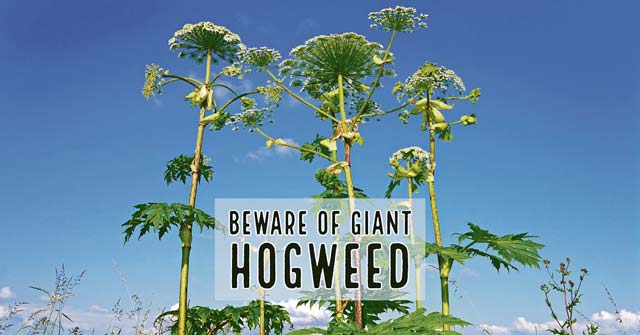
Enormous plants that cause painful burns, scarring and blindness may sound like something from a science-fiction movie, but they are real and have been found in Enkenbach-Alsenborn and the Glantal at district of Kusel, Germany.
Giant Hogweed or Heracleum mantegazzianum is a noxious weed that can grow up to 18 feet tall and is characterized by thick, bright green stems with purple splotches and white hairs. Its thick, jagged leaves can grow up to five feet wide with large clusters of tiny white flowers forming an umbrella pattern at the top of the plant. The sap is the most dangerous part of the plant, which contains toxic chemicals called furanocoumarins that cause severe burns when exposed to the sun’s ultraviolet rays.
Exposure symptoms to Giant Hogweed sap include:
- Painful blisters that form within 48 hours and become dark and pigmented
- Blister scars can last a few months to six years
- Longterm sensitivity to sunlight
- Blindness may occur, if the sap gets into the eye
People should avoid the plant whenever possible, but if the plant must be removed, follow these safety precautions:
- Do not touch the plant with bare skin
- Do not touch your bare skin with sap covered gloves or clothing
Prevent sap from reaching your skin by:
- Wearing long waterproof gloves, long-sleeve shirts, long pants, boots and eye protection; synthetic water-resistant materials are best since cotton and linen fibers can soak up the sap and be penetrated by plant hairs.
- If controlling plants with multiple people, keep a good distance from one another as the sap can splash three to four feet
- Apply sun block before beginning to work
- Launder clothes that may have contacted plants
- Wash equipment with water immediately after use
- Limit exposure to sunlight after control or work around Giant Hogweed plants after sunset
- Do not use a weed trimmer or brush cutter because sap may splatter when stems are cut
- Keep water, soap, and eye wash near work areas in case of exposure
- Do not mow or otherwise cut to control the plant mechanically. This increases the risk of exposure to the plant’s sap, and its roots will quickly grow new stalks. Place all plant parts inside heavy duty garbage bags for disposal.
For more information about Giant Hogweed, call the U.S. Army Garrison Rheinland-Pfalz Safety Office at 541-2302 or at 0611-143-541-2302.


